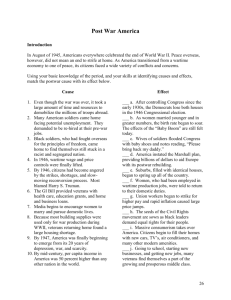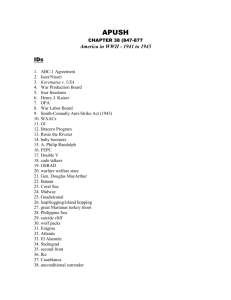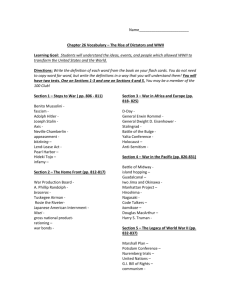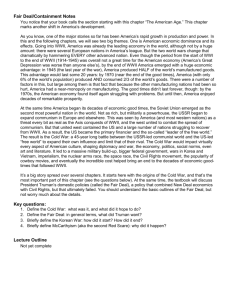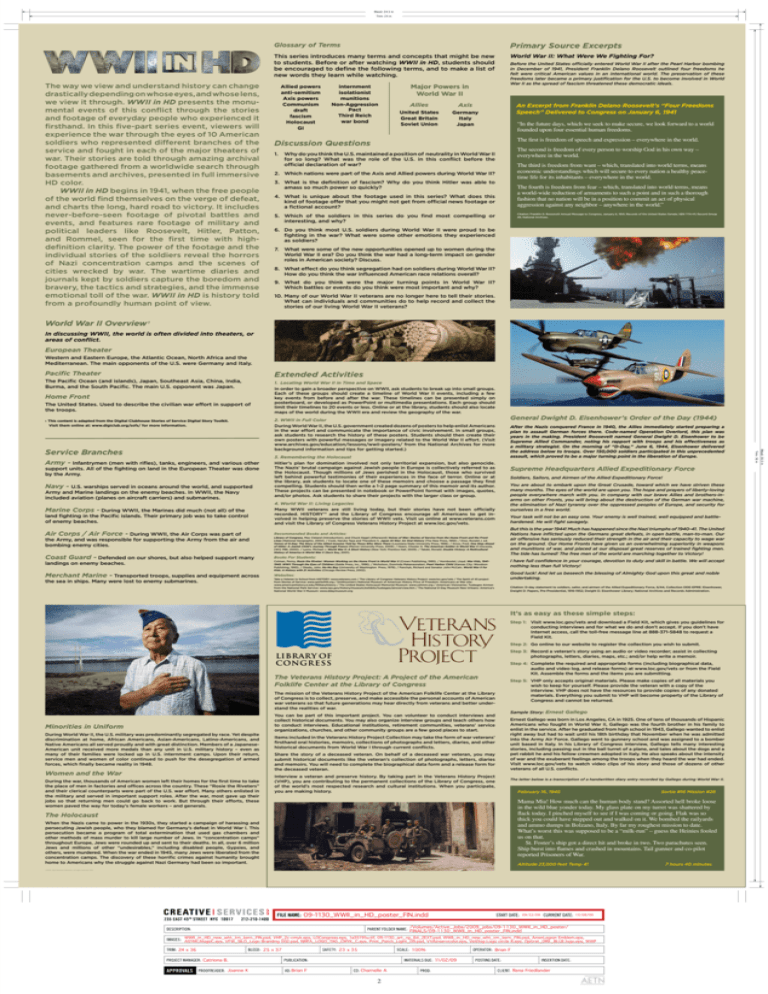
Bleed: 24.5 in
Trim: 24 in
The way we view and understand history can change
drastically depending on whose eyes, and whose lens,
we view it through. WWII in HD presents the monumental events of this conflict through the stories
and footage of everyday people who experienced it
firsthand. In this five-part series event, viewers will
experience the war through the eyes of 10 American
soldiers who represented different branches of the
service and fought in each of the major theaters of
war. Their stories are told through amazing archival
footage gathered from a worldwide search through
basements and archives, presented in full immersive
HD color.
WWII in HD begins in 1941, when the free people
of the world find themselves on the verge of defeat,
and charts the long, hard road to victory. It includes
never-before-seen footage of pivotal battles and
events, and features rare footage of military and
political leaders like Roosevelt, Hitler, Patton,
and Rommel, seen for the first time with highdefinition clarity. The power of the footage and the
individual stories of the soldiers reveal the horrors
of Nazi concentration camps and the scenes of
cities wrecked by war. The wartime diaries and
journals kept by soldiers capture the boredom and
bravery, the tactics and strategies, and the immense
emotional toll of the war. WWII in HD is history told
from a profoundly human point of view.
Glossary of Terms
Primary Source Excerpts
This series introduces many terms and concepts that might be new
to students. Before or after watching WWII in HD, students should
be encouraged to define the following terms, and to make a list of
new words they learn while watching.
World War II: What Were We Fighting For?
Allied powers
anti-semitism
Axis powers
Communism
draft
fascism
Holocaust
GI
internment
isolationist
munitions
Non-Aggression
Pact
Third Reich
war bond
Before the United States officially entered World War II after the Pearl Harbor bombing
in December of 1941, President Franklin Delano Roosevelt outlined four freedoms he
felt were critical American values in an international world. The preservation of these
freedoms later became a primary justification for the U.S. to become involved in World
War II as the spread of fascism threatened these democratic ideals.
Major Powers in
World War II
Allies
Axis
United States
Great Britain
Soviet Union
Germany
Italy
Japan
An Excerpt from Franklin Delano Roosevelt’s “Four Freedoms
Speech” Delivered to Congress on January 6, 1941
“In the future days, which we seek to make secure, we look forward to a world
founded upon four essential human freedoms.
The first is freedom of speech and expression – everywhere in the world.
Discussion Questions
The second is freedom of every person to worship God in his own way –
everywhere in the world.
1. Why do you think the U.S. maintained a position of neutrality in World War II
for so long? What was the role of the U.S. in this conflict before the
official declaration of war?
The third is freedom from want – which, translated into world terms, means
economic understandings which will secure to every nation a healthy peacetime life for its inhabitants – everywhere in the world.
2. Which nations were part of the Axis and Allied powers during World War II?
3. What is the definition of fascism? Why do you think Hitler was able to
amass so much power so quickly?
The fourth is freedom from fear – which, translated into world terms, means
a world-wide reduction of armaments to such a point and in such a thorough
fashion that no nation will be in a position to commit an act of physical
aggression against any neighbor – anywhere in the world.”
4. What is unique about the footage used in this series? What does this
kind of footage offer that you might not get from official news footage or
a fictional account?
Citation: Franklin D. Roosevelt Annual Message to Congress, January 6, 1941; Records of the United States Senate; SEN 77A-H1; Record Group
46; National Archives.
5. Which of the soldiers in this series do you find most compelling or
interesting, and why?
6. Do you think most U.S. soldiers during World War II were proud to be
fighting in the war? What were some other emotions they experienced
as soldiers?
7. What were some of the new opportunities opened up to women during the
World War II era? Do you think the war had a long-term impact on gender
roles in American society? Discuss.
8. What effect do you think segregation had on soldiers during World War II?
How do you think the war influenced American race relations overall?
9. What do you think were the major turning points in World War II?
Which battles or events do you think were most important and why?
10.Many of our World War II veterans are no longer here to tell their stories.
What can individuals and communities do to help record and collect the
stories of our living World War II veterans?
World War II Overview 1
In discussing WWII, the world is often divided into theaters, or
areas of conflict.
European Theater
Western and Eastern Europe, the Atlantic Ocean, North Africa and the
Mediterranean. The main opponents of the U.S. were Germany and Italy.
Pacific Theater
The Pacific Ocean (and islands), Japan, Southeast Asia, China, India,
Burma, and the South Pacific. The main U.S. opponent was Japan.
Home Front
The United States. Used to describe the civilian war effort in support of
the troops.
1
This content is adapted from the Digital Clubhouse Stories of Service Digital Story Toolkit.
Visit them online at: www.digiclub.org/sofs/ for more information.
support units. All of the fighting on land in the European Theater was done
by the Army.
Navy -
U.S. warships served in oceans around the world, and supported
Army and Marine landings on the enemy beaches. In WWII, the Navy
included aviation (planes on aircraft carriers) and submarines.
2.WWII in Full Color
During World War II, the U.S. government created dozens of posters to help enlist Americans
in the war effort and communicate the importance of civic involvement. In small groups,
ask students to research the history of these posters. Students should then create their
own posters with powerful messages or imagery related to the World War II effort. (Visit
www.archives.gov/education/lessons/wwii-posters/ from the National Archives for more
background information and tips for getting started.)
3.Remembering the Holocaust
Hitler’s plan for domination involved not only territorial expansion, but also genocide.
The Nazis’ brutal campaign against Jewish people in Europe is collectively referred to as
the Holocaust. Though millions of Jews perished in the Holocaust, those who survived
left behind powerful testimonies of their experiences in the face of terror. Online or at
the library, ask students to locate one of these memoirs and choose a passage they find
compelling. Students should then write a 1-2 page summary of this memoir and its author.
These projects can be presented in notebook or PowerPoint format with images, quotes,
and/or photos. Ask students to share their projects with the larger class or group.
land fighting in the Pacific islands. Their primary job was to take control
of enemy beaches.
4.World War II: Living Legacies
Many WWII veterans are still living today, but their stories have not been officially
recorded. HISTORY™ and the Library of Congress encourage all Americans to get involved in helping preserve the stories of WWII vets. Visit us online at www.veterans.com
and visit the Library of Congress Veterans History Project at www.loc.gov/vets.
Air Corps / Air Force - During WWII, the Air Corps was part of
Recommended Books and Articles:
Marine Corps - During WWII, the Marines did much (not all) of the
the Army, and was responsible for supporting the Army from the air and
bombing enemy cities.
Coast Guard - Defended on our shores, but also helped support many
landings on enemy beaches.
Merchant Marine - Transported troops, supplies and equipment across
the sea in ships. Many were lost to enemy submarines.
General Dwight D. Eisenhower’s Order of the Day (1944)
After the Nazis conquered France in 1940, the Allies immediately started preparing a
plan to assault German forces there. Code-named Operation Overlord, this plan was
years in the making. President Roosevelt named General Dwight D. Eisenhower to be
Supreme Allied Commander, noting his rapport with troops and his effectiveness as
a military strategist. On the morning of “D-Day,” June 6, 1944, Eisenhower delivered
the address below to troops. Over 150,000 soldiers participated in this unprecedented
assault, which proved to be a major turning point in the liberation of Europe.
Supreme Headquarters Allied Expeditionary Force
Soldiers, Sailors, and Airmen of the Allied Expeditionary Force!
You are about to embark upon the Great Crusade, toward which we have striven these
many months. The eyes of the world are upon you. The hope and prayers of liberty-loving
people everywhere march with you. In company with our brave Allies and brothers-inarms on other Fronts, you will bring about the destruction of the German war machine,
the elimination of Nazi tyranny over the oppressed peoples of Europe, and security for
ourselves in a free world.
Your task will not be an easy one. Your enemy is well trained, well equipped and battlehardened. He will fight savagely.
But this is the year 1944! Much has happened since the Nazi triumphs of 1940-41. The United
Nations have inflicted upon the Germans great defeats, in open battle, man-to-man. Our
air offensive has seriously reduced their strength in the air and their capacity to wage war
on the ground. Our Home Fronts have given us an overwhelming superiority in weapons
and munitions of war, and placed at our disposal great reserves of trained fighting men.
The tide has turned! The free men of the world are marching together to Victory!
Library of Congress, Max Cleland (Introduction), and Chuck Hagel (Afterword) Voices of War: Stories of Service from the Home Front and the Front
Lines (National Geographic, 2004). / Cook, Haruko Taya and Theodore S. Japan At War: An Oral History (The New Press, 1992). / Drez, Ronald J. ed.
Voices of D-Day: The Story of the Allied Invasion Told by Those Who Were There (Louisiana State University Press, 1996). / Gross, Fred. One Step Ahead
of Hitler: A Jewish Child’s Journey Through France (Mercer University Press, 2009). / Hearn, Chester G. The American Soldier in World War II (Osceola,
[WI]: MBI, 2000). / Lyons, Michael J. World War II: A Short History (New York: Prentice Hall, 2009). / Takaki, Ronald. Double Victory: A Multicultural
History of America in World War II (Back Bay, 2001).
Books For Students:
I have full confidence in your courage, devotion to duty and skill in battle. We will accept
nothing less than full Victory!
Colman, Penny. Rosie the Riveter: Women Working on the Home Front in World War II (Crown Publishing, 1995). / Hornbostel, Lloyd. War Kids, 19411945: WWII Through the Eyes of Children (Galde Press, Inc., 1996). / Nicholson, Donrinda Makanaonalani. Pearl Harbor Child (Kansas City: Woodson
Publishing, 1993). / Okada, John. No-No Boy (University of Washington Press, 1978). / Panchyk, Richard and Senator John McCain. World War II for
Kids: A History with 21 Activities (Chicago Review Press, 2002).
Good luck! And let us beseech the blessing of Almighty God upon this great and noble
undertaking.
Websites:
Take a Veteran to School from HISTORY: www.veterans.com / The Library of Congress Veterans History Project: www.loc.gov/vets / The Spirit of 45 project
from Stories of Service: www.spiritof45.org / Smithsonian’s National Museum of American History Price of Freedom: Americans at War site:
www.americanhistory.si.edu/Militaryhistory / The United States Holocaust Memorial Museum: www.ushmm.org / American Visionaries: Tuskegee Airmen
from the National Park Service: www.nps.gov/history/museum/exhibits/tuskegee/airoverview.htm / The National D-Day Museum New Orleans: America’s
National World War II Museum: www.ddaymuseum.org
Citation: D-day statement to soldiers, sailor, and airmen of the Allied Expeditionary Force, 6/44, Collection DDE-EPRE: Eisenhower,
Dwight D: Papers, Pre-Presidential, 1916-1952; Dwight D. Eisenhower Library; National Archives and Records Administration.
It’s as easy as these simple steps:
Step 1: Visit www.loc.gov/vets and download a Field Kit, which gives you guidelines for
conducting interviews and for what we do and don’t accept. If you don’t have
Internet access, call the toll-free message line at 888-371-5848 to request a
Field Kit.
Step 2: Go online to our website to register the collection you wish to submit.
Step 3: Record a veteran’s story using an audio or video recorder; assist in collecting
photographs, letters, diaries, maps, etc.; and/or help write a memoir.
Step 4: Complete the required and appropriate forms (including biographical data,
audio and video log, and release forms) at www.loc.gov/vets or from the Field
Kit. Assemble the forms and the items you are submitting.
The Veterans History Project: A Project of the American
Folklife Center at the Library of Congress
The mission of the Veterans History Project of the American Folklife Center at the Library
of Congress is to collect, preserve, and make accessible the personal accounts of American
war veterans so that future generations may hear directly from veterans and better understand the realities of war.
You can be part of this important project. You can volunteer to conduct interviews and
collect historical documents. You may also organize interview groups and teach others how
to conduct interviews. Educational institutions, retirement communities, veterans’ service
organizations, churches, and other community groups are a few good places to start.
Minorities in Uniform
During World War II, the U.S. military was predominantly segregated by race. Yet despite
discrimination at home, African Americans, Asian-Americans, Latino-Americans, and
Native Americans all served proudly and with great distinction. Members of a JapaneseAmerican unit received more medals than any unit in U.S. military history – even as
many of their families were locked up in U.S. internment camps. Upon their return,
service men and women of color continued to push for the desegregation of armed
forces, which finally became reality in 1948.
Women and the War
During the war, thousands of American women left their homes for the first time to take
the place of men in factories and offices across the country. These “Rosie the Riveters”
and their clerical counterparts were part of the U.S. war effort. Many others enlisted in
the military and served in important support roles. After the war, most gave up their
jobs so that returning men could go back to work. But through their efforts, these
women paved the way for today’s female workers – and generals.
Items included in the Veterans History Project Collection may take the form of war veterans’
firsthand oral histories, memoirs, collections of photographs and letters, diaries, and other
historical documents from World War I through current conflicts.
Share the story of a deceased veteran. On behalf of a deceased war veteran, you may
submit historical documents like the veteran’s collection of photographs, letters, diaries
and memoirs. You will need to complete the biographical data form and a release form for
the deceased veteran.
Interview a veteran and preserve history. By taking part in the Veterans History Project
(VHP), you are contributing to the permanent collections of the Library of Congress, one
of the world’s most respected research and cultural institutions. When you participate,
you are making history.
Step 5: VHP only accepts original materials. Please make copies of all materials you
wish to keep for yourself. Please provide the veteran with a copy of the
interview. VHP does not have the resources to provide copies of any donated
materials. Everything you submit to VHP will become property of the Library of
Congress and cannot be returned.
Sample Story: Ernest Gallego
Ernest Gallego was born in Los Angeles, CA in 1925. One of tens of thousands of Hispanic
Americans who fought in World War II, Gallego was the fourth brother in his family to
enlist in the service. After he graduated from high school in 1943, Gallego wanted to enlist
right away but had to wait until his 18th birthday that November when he was admitted
into the Army Air Force. Gallego went to gunnery school and was assigned to a bomber
unit based in Italy. In his Library of Congress interview, Gallego tells many interesting
stories, including passing out in the ball turret of a plane, and tales about the dogs and a
pet rabbit he and his fellow crewmen adopted in Italy. He also speaks about the intensity
of war and the exuberant feelings among the troops when they heard the war had ended.
Visit www.loc.gov/vets to watch video clips of his story and those of dozens of other
veterans of all U.S. conflicts.
The letter below is a transcription of a handwritten diary entry recorded by Gallego during World War II.
February 16, 1945 Sortie #16 Mission #28
Mama Mia! How much can the human body stand? Assorted hell broke loose
in the wild blue yonder today. My glass plate on my turret was shattered by
flack today. I pinched myself to see if I was coming or going. Flak was so
thick you could have stepped out and walked on it. We bombed the railyards
and ammo dumps in Bolzano, Italy. By far my roughest mission to date.
What’s worst this was supposed to be a “milk-run” – guess the Heinies fooled
us on that.
St. Foster’s ship got a direct hit and broke in two. Two parachutes seen.
Ship burst into flames and crashed in mountains. Tail gunner and co-pilot
reported Prisoners of War.
The Holocaust
When the Nazis came to power in the 1930s, they started a campaign of harassing and
persecuting Jewish people, who they blamed for Germany’s defeat in World War I. This
persecution became a program of total extermination that used gas chambers and
other methods of mass murder to kill large number of Jews. In “concentration camps”
throughout Europe, Jews were rounded up and sent to their deaths. In all, over 6 million
Jews and millions of other “undesirables,” including disabled people, Gypsies, and
others, were murdered. When the war ended in 1945, many Jews were liberated from the
concentration camps. The discovery of these horrific crimes against humanity brought
home to Americans why the struggle against Nazi Germany had been so important.
Altitude 23,000 feet Temp 41
©2009 A&E Television Networks. All rights reserved. 1130.
09-1130_WWII_in_HD_poster_FIN.indd
09/22/09
10/08/09
/Volumes/Active_Jobs/2009_jobs/09-1130_WWII_in_HD_poster/
FINALS/09-1130_WWII_in_HD_poster_FIN.indd
WWII_in_HD_new_wht_tm_kern_FIN.psd, VHP_2c-cmyk.eps, LOCongress.eps, 1a35195u.tif, 09-1130_art_rg_6d_2EXT.psd, WWII_in_HD_new_wht_tm_kern_FIN.psd, AmerLegion Emblem.eps,
ASYMCAlogoC.eps, VFW_SILO_Logo Branding 002.psd, NMFA_LOGO_TAG_CMYK_C.eps, Print_Patch_Light_09.psd, VVAinservcolor.eps, VetDog-Logo circle R.eps, OpGrat_DRK_BLUE.logo.eps, WWP
24 x 36
25 x 37
23 x 35
100%
Catriona B.
Joanne K
Brian F
11/02/09
Brian F
Charnelle A
2
Rena Friedlander
7 hours 40 minutes
Trim: 36 in
Army - Infantrymen (men with rifles), tanks, engineers, and various other
1. Locating World War II in Time and Space
In order to gain a broader perspective on WWII, ask students to break up into small groups.
Each of these groups should create a timeline of World War II events, including a few
key events from before and after the war. These timelines can be presented simply on
posterboard, or developed as PowerPoint or multimedia presentations. Each group should
limit their timelines to 20 events or less. Online or at the library, students should also locate
maps of the world during the WWII era and review the geography of the war.
Bleed: 36.5 in
Service Branches
Extended Activities

